| SJ23 Tech Tip B02, (Updated 2020-06-28) Bob Schimmel, Mike, Randy Cook. | ||
|
Cockpit Locker Starboard -
Convert from Shallow to Deep. |
||
| The starboard cockpit locker comes from the factory about 6" deep. This shallow depth is perfect for
short
lines, the winch handle, gum, etc. and
leave some legroom for the quarter berth under it. "I tried
sleeping there one night and the nicest thing I have to say about that
experience is the extra storage space far outweighs the sleeping
accommodation!"
VERSION 1 (PANACHE 2000) - My reason for cutting the bottom out of the starboard locker was to create a storage locker for wet lifejackets and fenders. I closed off the forward end of the locker with a teak plywood bulkhead equipped with a door to access the life jackets from the cabin. Ready access can't hurt. I also closed the 4" wide opening parallel to the cockpit foot well using 1/4" plywood. This prevents the jackets and fenders from sliding under the cockpit. The plywood divider is perforated with vent holes and coated with tung oil. Below are the before and after images of Panache's locker. CONSTRUCTION - To remove the bottom of the shallow locker;
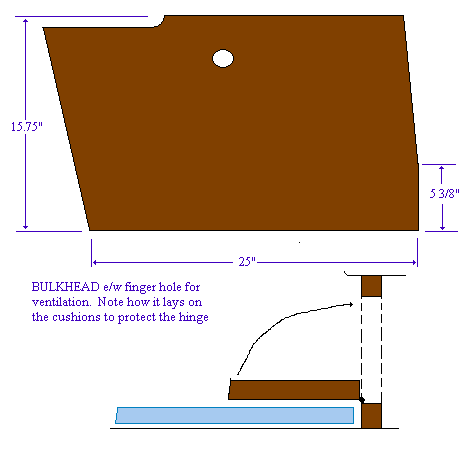 Below
is a cabin view of the finished forward end of the locker showing the
flip down door. The hinges were
installed at cushion height so the door can lie flat on the 3" thick cushion. The finger hole in the door doubles as a
bit of a "ventilation hole." The notch at the top is to fit
around the media player and instrument wiring (installed later) that passes through here. The dimensions are shown at the right. As
always, measure twice and cut once because the dimensions of Panache's
hull may not be exactly the same as your boat. Below
is a cabin view of the finished forward end of the locker showing the
flip down door. The hinges were
installed at cushion height so the door can lie flat on the 3" thick cushion. The finger hole in the door doubles as a
bit of a "ventilation hole." The notch at the top is to fit
around the media player and instrument wiring (installed later) that passes through here. The dimensions are shown at the right. As
always, measure twice and cut once because the dimensions of Panache's
hull may not be exactly the same as your boat.
A few years later I added a stiffening grab rail to the bottom of the
locker lid. It was an old grab rail I had laying around. Today
It doubles as a place to secure the fender lines. Its
better organized than it was before.
|
||
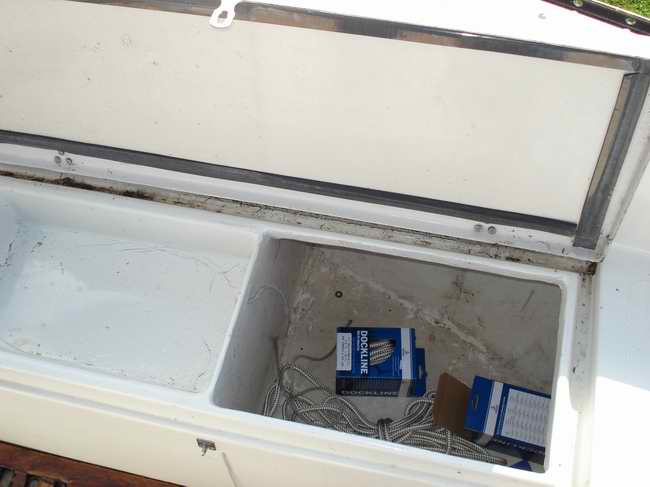 VERSION
2 (Mike) - Here
is Mike's version of modifying the starboard locker. He retained the water tight properties of the
locker with the dividing wall you see and another wall below the locker
foot well. VERSION
2 (Mike) - Here
is Mike's version of modifying the starboard locker. He retained the water tight properties of the
locker with the dividing wall you see and another wall below the locker
foot well.
I like the fact that the forward portion of the locker is accessible from the cabin and the aft portion from the cockpit. The locker could just as easily have been split at the 1/3 or 2/3 division. It just depends on what you want to store here. When I consider what I store in Panache's locker I would have installed the dividing wall at the forward end, creating a shallow cupboard on the cabin side. This would be really useful for electronics plus retain most of the water tight integrity of the cockpit. There is still an opening aft at the top, just under the gunwale. Hmmmm. It wouldn't be that difficult to install. Great things can happen when
you share an idea. |
||
|
2018 Drop Board Storage - Note the plywood on the right side. It is holding the companionway drop boards in the closed position, up tight against the inside of the locker. See Tech Tip B19. LOCKER GRATE (PANACHE 2019) - I don't often go to the bottom of this cockpit locker and while it
looked OK, it was quite a
job to sanitize after all these years. I used Fantastic that contains bleach to clean and kill the mould. Phew those fumes are strong with your head stuck in the locker. See Tech Tip G07 and safety notes at the bottom. Not again! So afterwards I installed vinyl interlocking grate on the bottom so
wet jackets and fenders can drip dry and ventilate from beneath.
The fibreglass will also get a chance to dry. The view at right is from inside
the cabin looking aft through a bulkhead door I built when I opened the
bottom of the starboard locker. See Tech Tip B13
for similar grate used on the cockpit sole. |
||
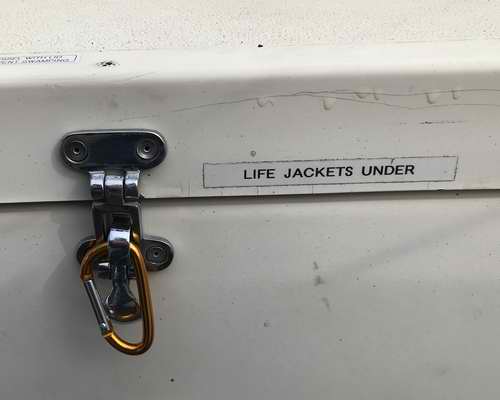 CAUTION
-
If you remove the bottom of the factory starboard "locker", it is
imperative you operate the boat with the
lid closed and latched with a positive securing, over center
cam latch (factory equipped or similar)
as shown at right. In fact this applies to both locker lids. A typical padlock hasp is only good when the boat is unattended in the marina. A carabineer works out on the water because it is secure and can readily be removed with your hand. In addition, you MUST install a rubber seal around the lid as described in Tech Tip B15.
I mention all this because if the boat broaches with the lid up or
unlatched you
have a 3 ft2 hole through which the cabin can flood.
That's a lot of water that will fill the aft end of the hull very quickly,
making it squat dangerously low in the water. The violent motion of
the hull can knock you down or the inflow of
water can push you aside so you can't reach the lid to close it in time. The next wave
will do its dastardly deed! Even if you install a sealed bulkhead at
the forward end of the locker and another one under the companionway, you
will likely have too much weight under the cockpit to control the boat. CAUTION
-
If you remove the bottom of the factory starboard "locker", it is
imperative you operate the boat with the
lid closed and latched with a positive securing, over center
cam latch (factory equipped or similar)
as shown at right. In fact this applies to both locker lids. A typical padlock hasp is only good when the boat is unattended in the marina. A carabineer works out on the water because it is secure and can readily be removed with your hand. In addition, you MUST install a rubber seal around the lid as described in Tech Tip B15.
I mention all this because if the boat broaches with the lid up or
unlatched you
have a 3 ft2 hole through which the cabin can flood.
That's a lot of water that will fill the aft end of the hull very quickly,
making it squat dangerously low in the water. The violent motion of
the hull can knock you down or the inflow of
water can push you aside so you can't reach the lid to close it in time. The next wave
will do its dastardly deed! Even if you install a sealed bulkhead at
the forward end of the locker and another one under the companionway, you
will likely have too much weight under the cockpit to control the boat.
Bobby Kawamura recalls hearing about an SJ24 that sunk on the Great Lakes in 1998. The boat has a similar locker that was open during a broach on a spinnaker run. The boat pitched sideways, flooding the locker. Then the stern squatted and it went down very quickly with loss of life. Affix the following label to the cockpit side of the lid. The owner may not be the only person who operates this boat and it will act as a reminder.
COCKPIT DRAIN RATE - Have you ever wondered how quickly the cockpit would drain if it shipped a large wave that fills the cockpit? Randy took measurements to determine where the water would flow first:
"The cockpit foot well holds 60 gallons (US) filled to just below the locker lids. It took 2 minutes to empty through the drain tubes, resulting in a flow rate of 30 gal/min. This is for a boat resting level on a trailer. I suspect it would take longer to drain if the boat is in a seaway that is bad enough to break a wave over the transom. Another consideration is how the boat will act with the weight of 60 gallons of
water in the cockpit. That comes to 500 lbs (514 lbs salt). Adding
this much weight would instantly make the stern squat, little doubt
about that. I'm not sure how much this squat would slow the flow
through the
submerged drain tubes. The numbers are accurate (tested) and
this information might save someone's life. Keep a bucket within easy reach!"
Randy. |
||
|
Return to Tech Tip Index. . . . . . . . . . . . . . . Have a Question? |
||
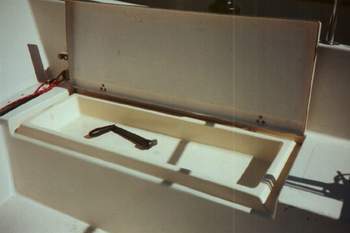
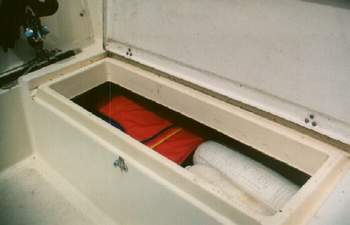
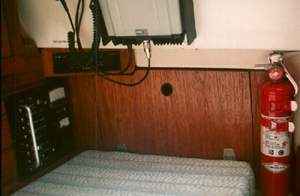
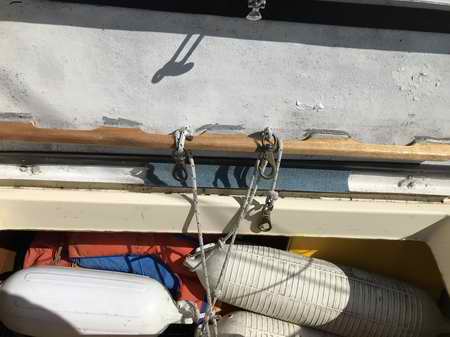 CONCLUSION -
CONCLUSION - 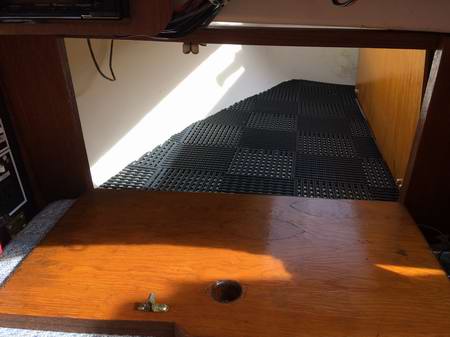 BULKHEAD (PANACHE 2017) - I removed the plywood bulkhead and door at the forward end of the locker to saturate the wood with
epoxy. This prevents end grain from absorbing water, something I should have done right from the start. All is good now
with the scupper on deck that is sealed and this bulkhead that is protected from
water.
BULKHEAD (PANACHE 2017) - I removed the plywood bulkhead and door at the forward end of the locker to saturate the wood with
epoxy. This prevents end grain from absorbing water, something I should have done right from the start. All is good now
with the scupper on deck that is sealed and this bulkhead that is protected from
water.